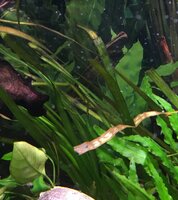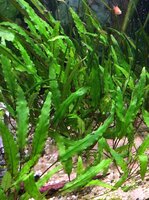My tank has been fertilised by the E.I method for a good few months now. I am achieving a nice lime green on my drop checker, all my water, filtration and light parameters are good. However, I cannot for the life of me get good Valois growth, in fact it seems to be breaking down. My anubias is static too. Weirdly my crypts are doing great. Any advice?
-
You are viewing the forum as a Guest, please login (you can use your Facebook, Twitter, Google or Microsoft account to login) or register using this link: Log in or Sign Up
You are using an out of date browser. It may not display this or other websites correctly.
You should upgrade or use an alternative browser.
You should upgrade or use an alternative browser.
Brown callus and static anubias growth
- Thread starter nilo
- Start date
Ryan Young
Member
- Joined
- 17 Jun 2015
- Messages
- 168
Could it be that although your light levels appear fine, some plants especially ones like these preference shade? This could be causing some problems also the vallis could be too much of a certain nutrients for them; again certain plants have certain preferences so might be the reason for some growing some not so much
Sent from my iPhone using Tapatalk
Sent from my iPhone using Tapatalk
Manisha
Member
Hi, I have a different set up (low tech) and had difficulty with vallis so asked here about alternatives as its such a nice plant 🙂 Suggestions included microsorum trident & needle leaf. Crypt balansae, sivadasanii, spiralas, & shola. Cyperus helferi, blyxa japonica, echinodorus latifolius, a variety of aponogeton & tall hair grass! I'd not thought there would be so much variety!
sciencefiction
Member
- Joined
- 26 Feb 2013
- Messages
- 3,412
When my lights failed and my valis wasnt getting enough of light, the tips started getting brown and the roots were short and weak. It looks similar to the ones in your picture.
So the problem is lack of light rather than too much light. Eventually, it will completely die off to a couple of plants or so if the light level is not improved
Crypts are normally very low light tolerant.
So the problem is lack of light rather than too much light. Eventually, it will completely die off to a couple of plants or so if the light level is not improved
Crypts are normally very low light tolerant.
sciencefiction
Member
- Joined
- 26 Feb 2013
- Messages
- 3,412
Not the best of pictures but that's what I took at the time.
I had lots of valis. As most know when it has its conditions, its invasive.
Valis stalks not getting enough light below. Pay attention to the missing tips just in front of the hose. What was happening was browning of the tops and them falling off. When I unplanted some, they were barely holding on to the substrate, they were so weak. Eventually the ones on these side of the tank died.

This one below is taken at exactly the same time but at the other side of the tank where the plants were getting a bit more light. However, even that was not sufficient. Valis likes light.

Try planting a few stalks in the most illuminated spot in the tank and see how it goes. However, any runners it sends might not be in a good position if light is the problem.
I had lots of valis. As most know when it has its conditions, its invasive.
Valis stalks not getting enough light below. Pay attention to the missing tips just in front of the hose. What was happening was browning of the tops and them falling off. When I unplanted some, they were barely holding on to the substrate, they were so weak. Eventually the ones on these side of the tank died.

This one below is taken at exactly the same time but at the other side of the tank where the plants were getting a bit more light. However, even that was not sufficient. Valis likes light.

Try planting a few stalks in the most illuminated spot in the tank and see how it goes. However, any runners it sends might not be in a good position if light is the problem.
sciencefiction
Member
- Joined
- 26 Feb 2013
- Messages
- 3,412
sciencefiction
Member
- Joined
- 26 Feb 2013
- Messages
- 3,412
C02 and light compensate for one another. Read about light/co2 compensation point.. Upping one of them may resolve the problem providing the plants get light above the min required for the species.
The pics i posted are after my lights failed when the valis was still hanging. I had a lot more light and afterward i eventually lost all valis on both sides of the tank though the one in the brighter side held in for longer
The pics i posted are after my lights failed when the valis was still hanging. I had a lot more light and afterward i eventually lost all valis on both sides of the tank though the one in the brighter side held in for longer
See this link, where importance of CO2 rather than light levels are discussed. I think I will tweak the CO2 a touch and see what happens?
http://www.ukaps.org/forum/threads/led-lighting.23932/page-2#post-245439
http://www.ukaps.org/forum/threads/led-lighting.23932/page-2#post-245439
sciencefiction
Member
- Joined
- 26 Feb 2013
- Messages
- 3,412
I have read all these posts over the years and more.
sciencefiction
Member
- Joined
- 26 Feb 2013
- Messages
- 3,412
Sorry I was being abrupt. I was posting from my phone and I hate them mobiles 😛
The light compensation point for plants is increased when you add more CO2 to the tank. So essentially plants that are lacking light can improve if more CO2 is added. The opposite is also true. Therefore the thread you referenced up there is one-sided and omitting vital information.
As I mentioned previously, increasing either the light or CO2 may help. The other option is, look into potassium and make sure you add enough. That's based on the pictures you gave.
And my advise is, observe, make one change at a time and see what helps in a particular situation. There is a lot of generalization going on that doesn't apply in each scenario. I've seen a lot of issues being contributed to lack of CO2 which are definitely not. And a lot of people repeat what they read here or elsewhere previously without trying it out for themselves.
Find one scientific paper that has explored the physical damage shown in plants due to lack of CO2....???? In fact there is none, because as scarce as CO2 is in aquariums, there is enough to prevent the plants from showing physical damage. If you see dying plants, yellowing, chlorosis, etc...its always nutrients and/or light related. Lack or low of CO2 slows the growth considerably. However, if you've got a light deficiency, high CO2 will compensate for that plant wise. Also having lower light and high CO2 will create an environment with less risk of getting algae because algae likes high light.
Hence why in the thread you quoted it is advised to concentrate on CO2 when keeping planted tanks so it does not get messy.. That's for beginners that just follow instructions like robots.... It's just one way of keeping plants but CO2 is not the solution to all issues or the only factor in place. CO2 is a cure for some issues and a growth booster, and also a vital nutrient as all the rest are too. If you lack one of all the factors, plants simply stop growing or grow so slowly that one can't notice....
The light compensation point for plants is increased when you add more CO2 to the tank. So essentially plants that are lacking light can improve if more CO2 is added. The opposite is also true. Therefore the thread you referenced up there is one-sided and omitting vital information.
As I mentioned previously, increasing either the light or CO2 may help. The other option is, look into potassium and make sure you add enough. That's based on the pictures you gave.
And my advise is, observe, make one change at a time and see what helps in a particular situation. There is a lot of generalization going on that doesn't apply in each scenario. I've seen a lot of issues being contributed to lack of CO2 which are definitely not. And a lot of people repeat what they read here or elsewhere previously without trying it out for themselves.
Find one scientific paper that has explored the physical damage shown in plants due to lack of CO2....???? In fact there is none, because as scarce as CO2 is in aquariums, there is enough to prevent the plants from showing physical damage. If you see dying plants, yellowing, chlorosis, etc...its always nutrients and/or light related. Lack or low of CO2 slows the growth considerably. However, if you've got a light deficiency, high CO2 will compensate for that plant wise. Also having lower light and high CO2 will create an environment with less risk of getting algae because algae likes high light.
Hence why in the thread you quoted it is advised to concentrate on CO2 when keeping planted tanks so it does not get messy.. That's for beginners that just follow instructions like robots.... It's just one way of keeping plants but CO2 is not the solution to all issues or the only factor in place. CO2 is a cure for some issues and a growth booster, and also a vital nutrient as all the rest are too. If you lack one of all the factors, plants simply stop growing or grow so slowly that one can't notice....
Last edited:






